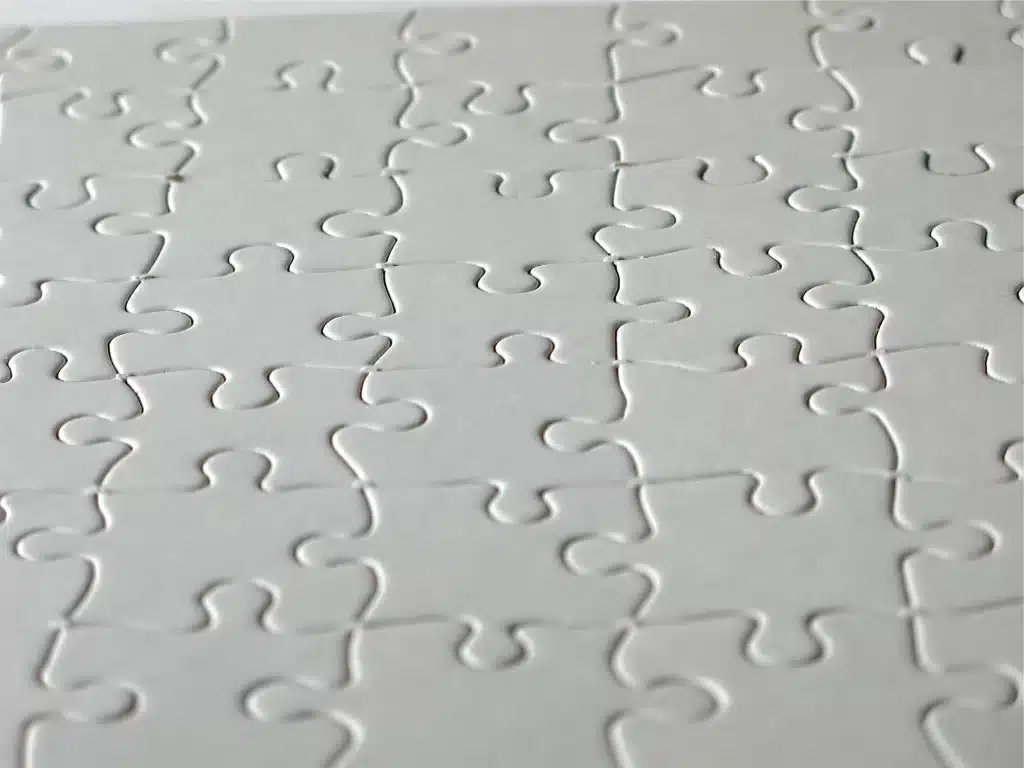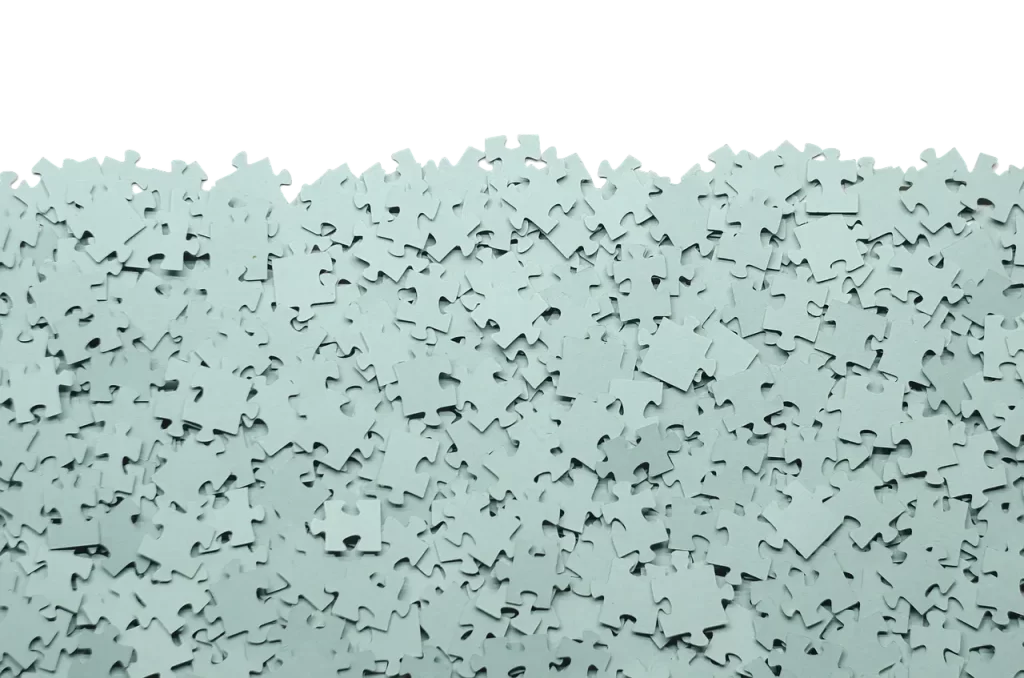Last Updated on February 22, 2024 by JigsawPuzzleGuru
Jigsaws with no picture present a unique challenge to puzzle enthusiasts. Traditional puzzles provide a reference image that serves as a guide to piece placement, but these picture-less variants require the assembler to rely strictly on the shapes of the pieces. This form of puzzle elevates the classic pastime from a visual to a tactile experience, engaging the solver in a game of pattern recognition and spatial reasoning without visual cues. Since the late 18th century, jigsaw puzzles have been enjoyed for their entertainment value, with the added benefit of refining cognitive abilities, and this new twist on the old game adds another layer of complexity.

The objective of a jigsaw puzzle is to assemble the interlocking pieces to create a complete picture. However, when assembling jigsaws without pictures to guide them, players must pay closer attention to the nuances of piece shapes. The color schemes are usually monochromatic or feature subtle gradations, compelling players to focus on minute details. This type of jigsaw puzzle makes for an intriguing game and an excellent tool for honing attention to detail and patience.
Puzzle makers who design jigsaws with no pictures aim to push the boundaries of what is conventionally expected from a puzzle. As a result, these puzzles cater to a niche market of individuals looking for a more formidable challenge than that offered by traditional jigsaws. Whether for sheer enjoyment or the mental workout they provide, jigsaw puzzles without pictures are carving out their own space in the world of games, appealing to those who are eager to test their mettle against an assembly of indistinguishable pieces.
Table of Contents
Unique Appeal of Picture-Less Jigsaws
Picture-less jigsaws, also known as mystery puzzles, cater to those seeking a higher difficulty level and immense satisfaction upon completion. They challenge conventional puzzle-solving by removing visual clues, which in turn provides distinctive benefits.
Cognitive Benefits
These puzzles serve as a robust workout for the brain. Adults engaged in assembling picture-less jigsaws must rely heavily on shape and pattern recognition, which stimulates cognitive function. The requirement to sort pieces based on subtle texture changes or slight color variations enhances attention to detail and can improve memory.
- Memory Boost: Sorting without a guide requires recalling subtle differences, strengthening memory.
- Problem-Solving Growth: Deciphering a picture-less puzzle promotes development of effective problem-solving strategies.
Enhancing Spatial Reasoning
Spatial reasoning is a critical skill sharpened by picture-less jigsaws. Participants must conceptualize the finished product without a reference, boosting their ability to understand and manipulate space. Assembling such puzzles necessitates a heightened perception of how individual pieces fit into a larger structure, refining spatial intelligence.
- Visualization: Imagining the final assembly without a guide enhances mental imagery capabilities.
- Piece Placement: Expertise in determining correct piece placement is gained through trial and error.
The Thrill of the Unknown
Mystery puzzles offer an element of surprise and excitement associated with the unknown. The lack of a guiding image transforms the assembly process into a thrilling discovery journey. It’s the wonder of seeing how disparate pieces come together as a cohesive whole that truly captivates adults seeking fun and unique challenges.
- Discovery Joy: With each correctly placed piece, puzzlers unravel part of the mystery, adding to the fun.
- Achievement Satisfaction: The intense challenge leads to a high sense of accomplishment once completed.

Setting Up for Jigsaw Success
The task of piecing together a jigsaw with no picture requires a carefully arranged workspace and systematic approach. Success depends on the choice of table, assembly strategy, and efficient time management.
Choosing the Right Table
Selecting an appropriate table is the foundation of a good jigsaw experience. One should seek a table with a non-reflective surface that is large enough to accommodate the spread of all pieces and provides a buffer area for grouping. The table should also be comfortably high to prevent back strain during prolonged periods of puzzle assembly. A map or mat used on the table to provide a grid for helping organize pieces by shape or subtle color differences is helpful.
Strategies for Assembly
Without a preview image, a jigsaw assembler must rely on the shape and cut of the pieces. Initially, separating pieces by edge status (border or interior) and color can expedite the assembly process. They could start by constructing the border frame and then grouping pieces based on the nature of their connection points, such as knobs, holes, wings, and sockets. This methodical approach will produce micro clusters. These can then can be combined as the puzzle progresses, increasing the assembly score for completed sections.
Time Management for Puzzlers
Effective time management is crucial when tackling a complex jigsaw puzzle. Puzzlers should set realistic goals and break the task into sessions to maintain enthusiasm and avoid fatigue. Using a timer can create a sense of urgency that can boost focus. Scheduling breaks after completing specific goals, such as the border or a color section, helps maintain a steady pace and prevents the experience from becoming overwhelming.










